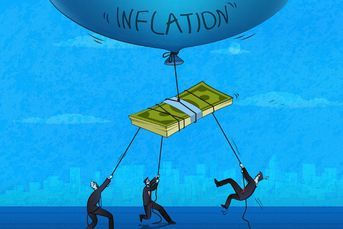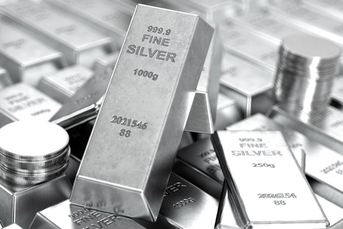Strategists: Unforeseen rally an ominous sign for market
The 13% rally in the S&P 500 has lifted the gauge to one of the highest levels ever…
The 13% rally in the S&P 500 has lifted the gauge to one of the highest levels ever over strategists' forecasts, a sign that the best may be over for U.S. equities this year.
Shares have climbed about 2.1% above the average projection of 1,389 from 13 firms — ranging from JPMorgan Chase & Co. to Morgan Stanley — tracked by Bloomberg. That is the biggest premium on record for this time of year, according to data going back to 1999.
August estimates by strategists have come true the past three years, the data show.
Weakening earnings at companies ranging from Advanced Micro Devices Inc. (AMD) to Wynn Resorts Ltd. (WYNN), the U.S. presidential elections and the eurozone debt crisis mean that stocks are unlikely to climb, said Jonathan Golub, the chief U.S. equity strategist at UBS Investment Bank.
“When you look at the lack of earnings growth and economic growth, there's just no reason for the stock market to have to go higher,” Mr. Golub said.
“There's the election, and you have questions about monetary policy in the U.S.,” he said. “You have a situation in Europe, and no matter how good anybody is feeling about it today, it's not resolved.”
Those concerns, however, already are reflected in valuations, which are 12% below the almost six-decade average, according to Thomas Lee, chief U.S. equity strategist for JPMorgan Chase. He believes shares have room to keep rising in an expanding economy.
ECONOMIC REPORTS
Mr. Golub forecasts that the S&P 500 will end the year at 1,375, or 3% below the closing level Aug. 17.
Strategist calls have been an average of 9.1% above the S&P 500 at this time of year since 1999 and have never been below, data compiled by Bloomberg show. Wall Street firms, in the past three years, estimated gains of 10.3% for the first half of each year. The benchmark index's mean advance was 10.6%over the three periods, the data show.
This year, strategists lifted the average prediction of 1,344 in January to 1,387 in April and to 1,400 on May 8, a month after the gauge peaked at 1,419.04. The estimate came down as the benchmark index lost 9.9% through June 1.
Speculation that Europe's debt crisis and China's slowdown will curtail growth has bolstered bets that central banks will continue to support the global economic recovery and has sent the S&P 500 up 11% since June. The People's Bank of China cut interest rates twice this year, while the Federal Reserve and the European Central Bank signaled that they may initiate economic stimuli.
“More fear about the U.S. earnings trajectory” will be a catalyst that sends stocks lower, said Adam Parker, a U.S. equity strategist at Morgan Stanley, whose estimate last year proved the most accurate.
2013 FORECAST: $99 A SHARE
“People have not been bearish about earnings. They believe that earnings are only going to modestly decline, and our view is that 2013 earnings are going to be about $99 [per share],” Mr. Parker said.
That would be about 4% below the analyst consensus, Bloomberg data show.
Mr. Parker forecasts that the S&P 500 will slide 18% to 1,167.
The continuing crisis in the eurozone and decelerating economies in emerging markets may weigh down equities, Mr. Parker said.
Analysts have trimmed earnings estimates since the year started. They project that S&P 500 companies will earn a total of $103.18 a share in 2012, down from $105.27 at the beginning of the year. Their estimate, however, is for earnings to hit $115.33 next year.
Analysts still are more optimistic than strategists, whose forecasts are 1.7% lower for this year and 7.7% below the projection for next year.
WEAKEST QUARTER
Second-quarter earnings were the weakest in three years, Bloomberg data show. Sales growth slowed to 0.8% and profit increased 0.3%, the worst quarter since the second half of 2009.
Advanced Micro Devices, the second-biggest maker of processors for personal computers, posted a second-quarter profit of 5 cents a share, down 3 cents from 2011. Revenue fell 10% to $1.41 billion, and the company predicted sales from July through September will decline as much as 4% sequentially as demand for PCs is cut by the slowing economy.
Wynn, the casino company run by billionaire Steve Wynn, reported last month that second-quarter earnings and sales dropped because of lower winnings in Macau and Nevada.
Excluding items, profit was $1.38 a share, compared with $1.60 a year earlier. Revenue declined 8.3% to $1.25 billion, the company said.
GDP GROWTH
Gross domestic product in the United States probably will expand at a 2.2% rate in 2012, compared with 1.8% last year, according to the median estimate of 78 economists surveyed by Bloomberg. The eurozone economy is estimated to contract 0.5% after rising last year.
The growth rate in China is forecast to slow to 8.2%, from 9.2%.
The stronger U.S. expansion will support earnings and make stocks bargains, according to Mr. Lee.
He estimates that the S&P 500 will rise another 0.8% to 1,430 this year.
The index's price-earnings ratio was 14.4 for the week ended Aug. 17, down from 18.9 in March 2010 and below the 16.4 average since the 1950s, according to data compiled by Bloomberg.
“I'm not superworried about earnings,” Mr. Lee said. “Economic data are starting to pick up.”
Although the recovery is slowing in Europe and China, “it's already reflected in the forecast,” Mr. Lee said.
The S&P 500 may reach 1,500 this year as the economy gains momentum in the fourth quarter, according to Byron Wien, vice chairman of Blackstone Group LP's advisory services unit.
His estimate is above the highest projection from the 13 strategists tracked by Bloomberg and 4.3% off the 1,565.15 all-time peak reached in October 2007.
“Housing is bottoming, gasoline is down from the beginning of the year, and 90% of the people in the country have jobs,” Mr. Wien told Bloomberg Television in an interview Aug. 15.
“The European situation is getting better — not resolved, but getting better,” he said. “There will be more good news than bad.”
The S&P 500 has posted average annual gains of 3% in the past decade, ending little changed last year after rising 13% in 2010 and 23% in 2009. The average annual increase since 1992 is 7.4%.
About 46.1% of S&P 500 sales last year came from outside the United States, according to an Aug. 9 S&P Dow Jones Indexes study by Howard Silverblatt, a senior index analyst at Standard & Poor's. Based on information reported by 252 companies, the percentage is down from 46.3% in 2010 and 47.9% in 2008.
Technology stocks had the biggest proportion of sales from overseas, with 57%, the report said.
“The broader macro growth environment, particularly international, which has been a bigger driver of earnings than was the case in past cycles, looks pretty bleak,” said Barry Knapp, head of U.S. equity strategy at Barclays PLC, who estimates that the S&P 500 will fall to 1,330 by year-end. “The risks are getting bigger and bigger.”
Learn more about reprints and licensing for this article.








